Offshore wind farms could offset billions of dollars in climate change-related costs in the Pacific Northwest – reportStaff Writer | October 22, 2023 |
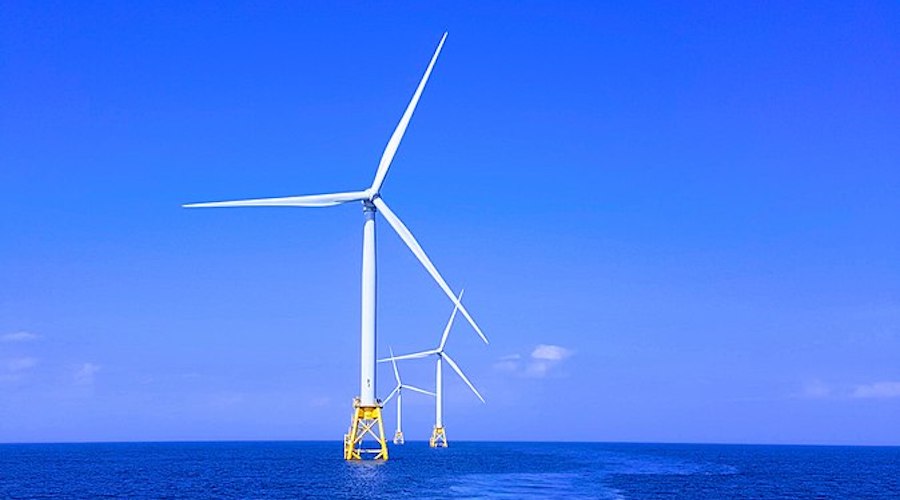
Offshore wind turbines. (Reference image by Shaun Dakin, Wikimedia Commons.)
Floating wind farms off the coast of southern Oregon and northern California could triple the Pacific Northwest’s wind power capacity while offsetting potentially billions of dollars in costs for utilities, ratepayers, insurance companies, and others who bear the cost of climate change’s effects, according to new research.

“This research is all about unlocking an untapped source of supply where there is limited transmission and little ability to move that electricity today,” said Travis Douville, lead author of the report that presents this idea and an advisor at the Pacific Northwest National Laboratory.
The US’s power supply is split into three separate grids, with the western interconnection providing power to more than 80 million people over 14 states and two Canadian provinces. The new report dives into future scenarios where floating offshore wind farms are connected to the shore between Coos Bay, OR, and Eureka, CA, via large transmission lines—and the value those wind farms could bring to utilities and ratepayers alike.
Land-based wind farms across the United States already produce more than 140 gigawatts of energy, contributing to about 10% of the nation’s energy portfolio. Currently, the federal government aims to install 30 gigawatts of offshore wind by 2030 and to increase that number to 110 gigawatts of offshore wind by 2050. That much wind power could power tens of millions of homes and cut more than 78 million metric tons of carbon emissions.
Mark Severy, a research engineer at PNNL and co-author on the report, also explained that one of the perks of offshore wind turbines—whether they’re attached to the ocean floor or floating on the surface—versus land-based is that wind over the ocean is less variable and more consistent.
Wind over the ocean also tends to peak in the evenings, which could help supply power when solar energy dips as the sun sets. In places like California, where solar energy makes up most of the renewable power, utilities could turn to wind power in the evenings, when demand generally goes up, instead of fossil fuels to power homes.
Existing infrastructure
One challenge to this idea is determining whether existing transmission infrastructure could support incoming energy from offshore wind.
In a previous study, Douville and other researchers found that offshore wind could supply 3 gigawatts of energy with upgrades to Oregon’s current transmission lines. That’s enough energy to power 1 million homes.
“How do you harness offshore wind energy in a way that allows you to adequately, reliably, and resiliently supply electricity in the future at the lowest cost?” Douville said. “And what is the role of transmission design to influence the value of offshore wind?”
To find out, the team modelled different transmission scenarios, two of which represent a future where offshore wind farms and new, powerful transmission lines add an additional 20 gigawatts worth of wind power to the western interconnection. Both scenarios include high-voltage direct current (HVDC) transmission lines to carry power, which would then be converted to alternating current (AC) once onshore.
The two scenarios differ in whether each wind farm is connected separately to the shore (in a radial structure) or whether the wind farms are connected to each other, then to the shore (a backbone structure).
Severy noted that although both transmission scenarios offered millions of dollars in value, the backbone structure offers slightly different benefits. In the radial scenario, power can only go to one place—wherever the wind farm is connected on the coast—and then be distributed from there. In the backbone structure, power can be diverted up and down the coast.
For example, “in times when there’s excess solar generation in California, we found that the backbone provides another pathway for that electricity to go to the Pacific Northwest and when there is a lot of hydropower in the Pacific Northwest, the backbone is another pathway south, outside of the congested transmission lines on the I-5 corridor,” Severy said.
Although either option would be expensive, “the benefits exceed the costs in nearly every scenario,” Douville said.
In those scenarios where benefits exceed the costs, the values of the various returns on investment range between $127 million and $6 billion. These numbers represent savings to produce and supply power as well as avoid the cost of the effects of air pollution and destruction wrought by climate-change-related disasters.
Remaining challenges
Douville stressed that many more questions need to be answered before an offshore wind plan can be executed.
For instance, researchers and policymakers need to consider how transmission lines will fare underwater. Sea floor depth and slope could affect where cables could be laid, and salt water can be very corrosive, said Jason Fuller, chief energy resilience engineer at the PNNL. Maintenance could be tough, depending on how deep the cables are laid. In addition, the US simply hasn’t used HVDC as much as AC on the grid, and modelling HVDC with current tools can be difficult.
Researchers and policymakers will also have to consider other stakeholders who depend on the ocean, including fisheries and other coastal communities.

Offshore wind turbines. (Reference image by Shaun Dakin, Wikimedia Commons.)

“This research is all about unlocking an untapped source of supply where there is limited transmission and little ability to move that electricity today,” said Travis Douville, lead author of the report that presents this idea and an advisor at the Pacific Northwest National Laboratory.
The US’s power supply is split into three separate grids, with the western interconnection providing power to more than 80 million people over 14 states and two Canadian provinces. The new report dives into future scenarios where floating offshore wind farms are connected to the shore between Coos Bay, OR, and Eureka, CA, via large transmission lines—and the value those wind farms could bring to utilities and ratepayers alike.
Land-based wind farms across the United States already produce more than 140 gigawatts of energy, contributing to about 10% of the nation’s energy portfolio. Currently, the federal government aims to install 30 gigawatts of offshore wind by 2030 and to increase that number to 110 gigawatts of offshore wind by 2050. That much wind power could power tens of millions of homes and cut more than 78 million metric tons of carbon emissions.
Mark Severy, a research engineer at PNNL and co-author on the report, also explained that one of the perks of offshore wind turbines—whether they’re attached to the ocean floor or floating on the surface—versus land-based is that wind over the ocean is less variable and more consistent.
Wind over the ocean also tends to peak in the evenings, which could help supply power when solar energy dips as the sun sets. In places like California, where solar energy makes up most of the renewable power, utilities could turn to wind power in the evenings, when demand generally goes up, instead of fossil fuels to power homes.
Existing infrastructure
One challenge to this idea is determining whether existing transmission infrastructure could support incoming energy from offshore wind.
In a previous study, Douville and other researchers found that offshore wind could supply 3 gigawatts of energy with upgrades to Oregon’s current transmission lines. That’s enough energy to power 1 million homes.
“How do you harness offshore wind energy in a way that allows you to adequately, reliably, and resiliently supply electricity in the future at the lowest cost?” Douville said. “And what is the role of transmission design to influence the value of offshore wind?”
To find out, the team modelled different transmission scenarios, two of which represent a future where offshore wind farms and new, powerful transmission lines add an additional 20 gigawatts worth of wind power to the western interconnection. Both scenarios include high-voltage direct current (HVDC) transmission lines to carry power, which would then be converted to alternating current (AC) once onshore.
The two scenarios differ in whether each wind farm is connected separately to the shore (in a radial structure) or whether the wind farms are connected to each other, then to the shore (a backbone structure).
Severy noted that although both transmission scenarios offered millions of dollars in value, the backbone structure offers slightly different benefits. In the radial scenario, power can only go to one place—wherever the wind farm is connected on the coast—and then be distributed from there. In the backbone structure, power can be diverted up and down the coast.
For example, “in times when there’s excess solar generation in California, we found that the backbone provides another pathway for that electricity to go to the Pacific Northwest and when there is a lot of hydropower in the Pacific Northwest, the backbone is another pathway south, outside of the congested transmission lines on the I-5 corridor,” Severy said.
Although either option would be expensive, “the benefits exceed the costs in nearly every scenario,” Douville said.
In those scenarios where benefits exceed the costs, the values of the various returns on investment range between $127 million and $6 billion. These numbers represent savings to produce and supply power as well as avoid the cost of the effects of air pollution and destruction wrought by climate-change-related disasters.
Remaining challenges
Douville stressed that many more questions need to be answered before an offshore wind plan can be executed.
For instance, researchers and policymakers need to consider how transmission lines will fare underwater. Sea floor depth and slope could affect where cables could be laid, and salt water can be very corrosive, said Jason Fuller, chief energy resilience engineer at the PNNL. Maintenance could be tough, depending on how deep the cables are laid. In addition, the US simply hasn’t used HVDC as much as AC on the grid, and modelling HVDC with current tools can be difficult.
Researchers and policymakers will also have to consider other stakeholders who depend on the ocean, including fisheries and other coastal communities.
Huisman Launches Wind Detection System for Safer Wind Turbine Installation
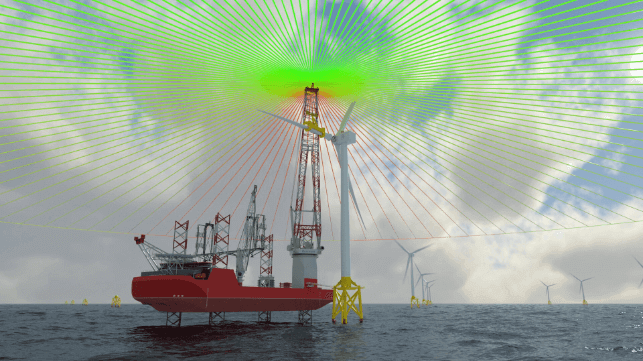
[By: Huisman]
Huisman has announced the launch of a newly developed system that empowers crane operators with the ability to anticipate and react to approaching wind speeds, gusts, and direction during the installation process of turbine blades.
The system, called Wind Gust Buster assists crane operators and lifting supervisors when working with the installation of large objects at considerable height, by providing information on the incoming wind 360° around the boom tip. Measurement of the incoming wind is done by application of a LiDAR system on the crane’s boom tip, scanning the horizontal area. The measurement data is post-processed by the crane’s automation system and can be shown to both the crane operator as well as to other people involved, such as on the crane vessel’s bridge. A typical prediction window is five to eight minutes ahead of the wind gust coming in, which allows sufficient time to make the “go or no-go” decision for mating a blade to a nacelle.
The system can be installed on newly built Huisman cranes as well as retrofitted to existing ones.
Cees van Veluw, Product Director Cranes of Huisman: “We are constantly looking for new developments to further improve safety in turbine installation operations. Right now, sudden wind gusts acting on turbine blades can pose a safety risk to the people in the wind turbine, as well as an integrity risk to the blade and nacelle. While we all get used to checking the rain radar prior to taking a hike outside, we haven’t seen this used the same way in turbine installation before. The Wind Gust Buster improves the crane operator’s ability to mate the blade in a controlled manner and thus contributes to safety of the whole lifting operation. Furthermore, this can lead to less damage to components like the blade’s stud bolts, and thus can lead to a cost reduction and installation speed improvement.”
The development of this system contributes to Huisman’s ambition to improve the installation of offshore wind turbines. Another recently introduced solution for controlled installation of blades is the Travelling Load Stabilising System that the company has developed in cooperation with Siemens Gamesa.
Features of the Huisman Wind Gust Buster
- Measurement of approaching wind speed and direction up to 10km distance.
- Sudden changes in the wind speed are detected in advance allowing crew member, like the person guiding the blade into the nacelle, to be informed.
- Unobstructed measurement of the wind speed as the sensor is placed on the top of the boom avoiding unnesery downtime by inaccurate wind speed measurement due to sensor blockage.
The products and services herein described in this press release are not endorsed by The Maritime Executive.
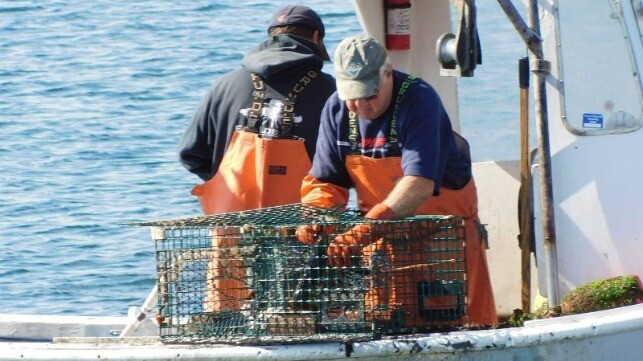
PUBLISHED OCT 19, 2023 9:36 PM BY THE MARITIME EXECUTIVE
The U.S. Bureau of Ocean Energy Management (BOEM) is rolling out designated offshore wind leasing areas off the lower 48 states at a rapid clip, racing to meet the Biden administration's target of 30 gigawatts of capacity by 2030. For the latest - a 3.5 million acre parcel in the Gulf of Maine - it has decided to dodge a looming fight with fishing and environmental interests.
The newly-released Draft Wind Energy Area for the Gulf of Maine has enough room for up to 40 gigawatts of offshore wind capacity, with a focus on floating wind installations in deeper water. The size is notable, but the most conspicuous part is the part that was left out: NOAA Lobster Management Area 1, a strip along the coast that is essential to the powerful Maine lobster industry.
Large swathes of LMA 1 were included in the original call area, the starting-point chart that BOEM released in April. The Maine Lobstering Union was not interested in giving up its primary fishing grounds, and it teamed up with environmental groups to lobby BOEM to keep offshore turbines out of the management area. Maine's entire congressional delegation joined the push, including Sen. Susan Collins (R-ME), vice-chair of the Senate Appropriations Committee.
On Thursday, the union declared success: the desirable near-coastal waters of LMA 1 are out of the planning for wind development.
“This is how the process is supposed to work. The federal government listened to the concerns of our fishing communities, and now they are sending a strong signal that an offshore wind industry that fundamentally harms the hardworking Mainers making their living on the water is neither in line with Maine’s values nor welcome in the Gulf of Maine,” said Virginia Olsen, Executive Director, Maine Lobstering Union, Local 207.
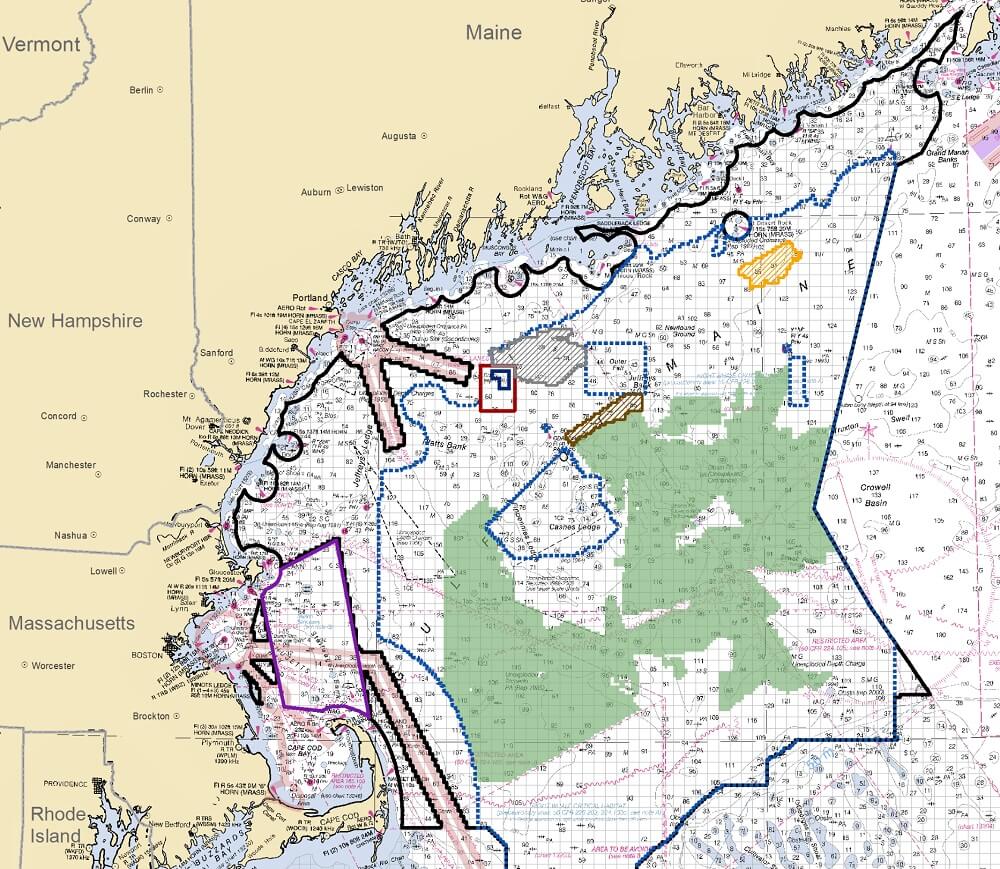
The proposed Wind Energy Area for the Gulf of Maine, shaded in green (BOEM)
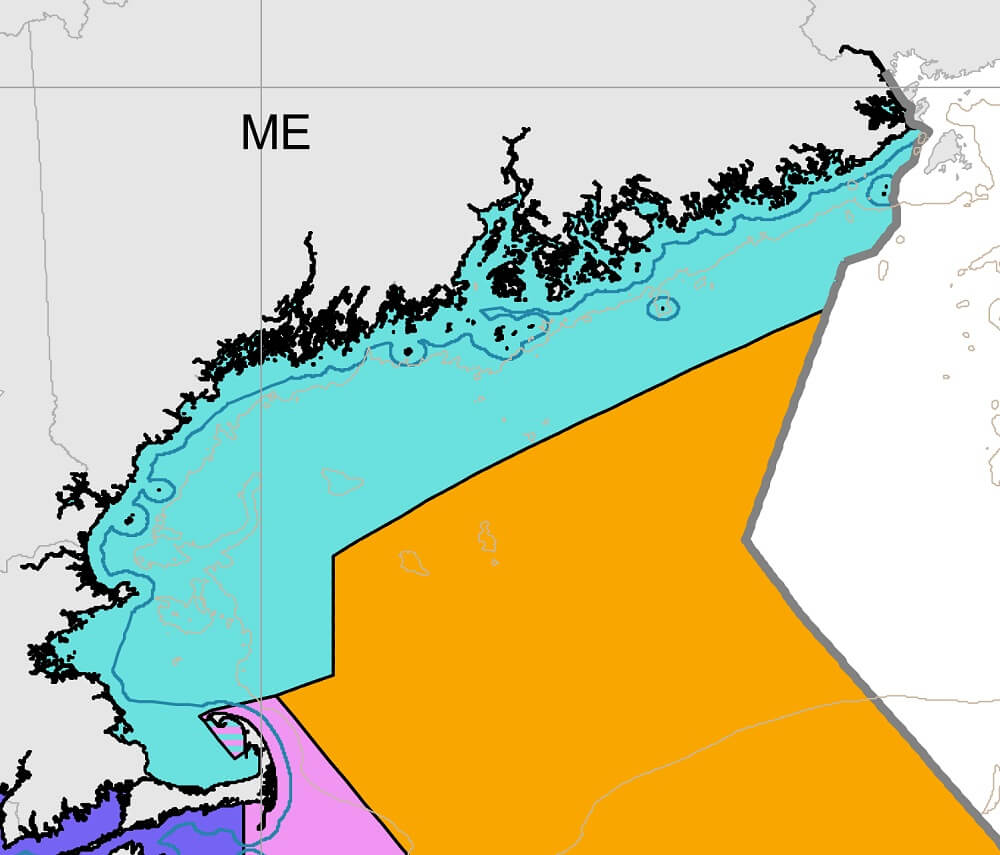
Lobster Management Area 1, in green above, has almost no overlap with the proposed Wind Energy Area (NOAA)
The proposed development area has plenty of room elsewhere for turbines, and the State of Maine is bullish on the prospects for offshore wind. In July, its legislature approved an RFP for about three gigawatts of offshore wind turbine capacity by 2040, or about half of all state power requirements. The bill contains incentives for wind developers who stay out of prime lobster territory. The RFP will be released in 2026, after anticipated federal lease sales.
"It’s clear that this effort [the green transition] will involve offshore wind energy projects,” said the bill's sponsor, State Senator Mark Lawrence, in a statement at its passage in July. "If we know this is coming, we need to have guardrails in place to make sure this is done right and truly benefits Mainers."
Top image: Maine lobstermen working their pots, 2016 (AK-Bino / CC BY SA 4.0)
Vineyard Wind Completes First Wind Turbine Installation Milestone
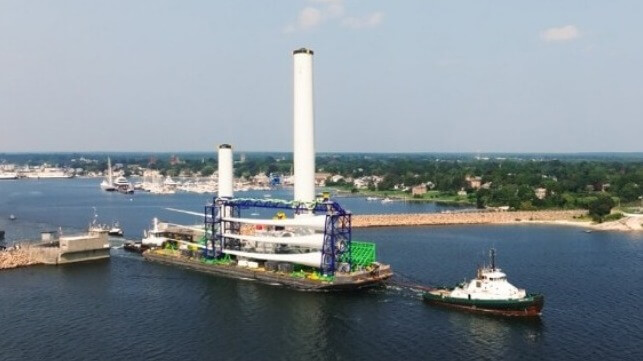
After weeks of negative developments and reports questioning the viability of the U.S. offshore wind industry, Iberdrola Group’s Avangrid and Copenhagen Infrastructure Partners are highlighting advancements at the Vineyard Ward 1 project as a demonstration of the industry’s progress. A little over a month after the first turbine was moved from the staging facility in Massachusetts, the installation was completed.
The first of 62 GE Haliade-X Wind Turbine Generator has been successfully installed at the site which is 15 miles off the coast of Martha’s Vineyard. Each of the turbines will have a capacity of 13 MW with the project slated to have a total capacity of 806 MW. The companies note that the fully assembled machine, which is comprised of one tower, three blades, and one nacelle, represents the largest turbine in the Western world.
“This is a monumental achievement and a proud day for offshore wind in the United States that proves this industry is real and demonstrates Avangrid’s steadfast commitment to helping the Northeast region meet its clean energy and climate goals,” said Avangrid CEO Pedro Azagra. “While this is a landmark for this first-in-the-nation project and the industry, we remain focused on the important work ahead to continue the successful installation campaign of these massive turbines and deliver the first power to Massachusetts homes and businesses this year.”
Avangrid looks to use these developments to offset some of the negative reports after the company reached agreements with both Massachusetts and Connecticut to walk away from power purchase agreements for two other wind farms that are currently in the permitting and pre-development stage. Avangrid agreed to pay fines in both states and to have the Commonwealth Wind and Park City Wind projects rebid in future solicitations. Shell and OceanWinds, a joint venture between EDP Renewables and ENGIE, similarly agreed during the summer to cancel the power purchase agreement for SouthCoast Wind also planned for Massachusetts. New York regulators last week also refused three petitions from wind farm developers to adjust power purchase agreements.
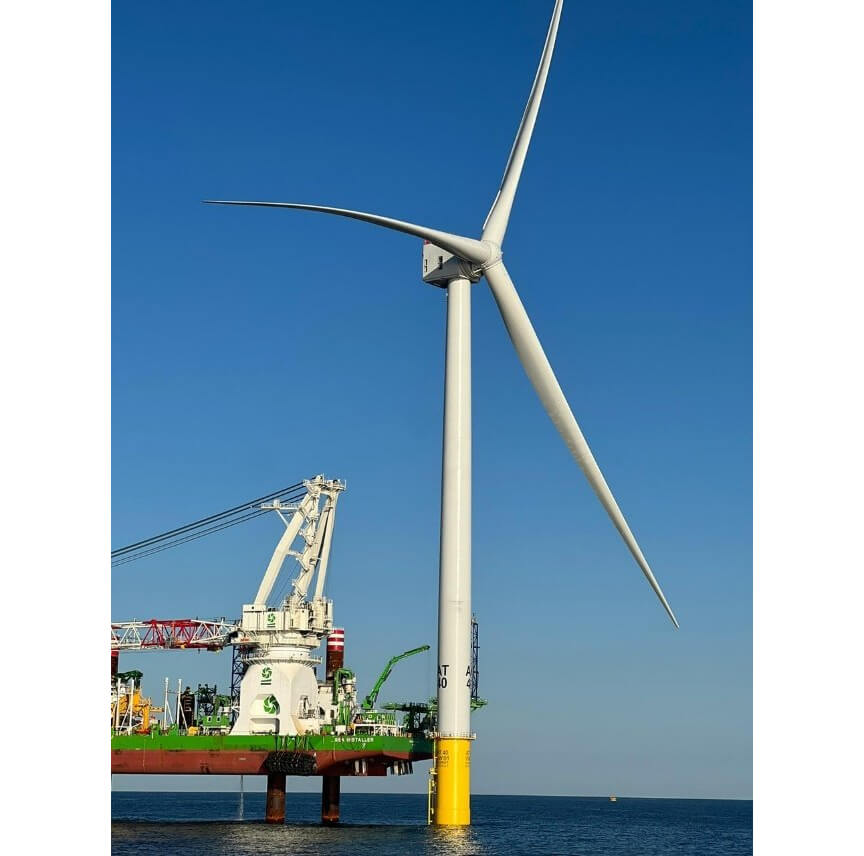
Vineyard Wind's first turbine installation has been completed
“Having the first offshore wind turbine in the water for the first commercial offshore wind farm in the U.S. is an important symbolic milestone for our company, our customers, and our industry,” said Jan Kjaersgaard, CEO of GE Vernova Offshore Wind.
Vineyard Wind began offshore construction in late 2022. It achieved steel-in-the-water in June and the wind farm’s substation was completed in July. The company has projected that the first turbines will begin generating power before the end of this year and the project will be completed in 2024.
To meet the U.S. Jones Act requirements, the project is using a broad partnership with the staging of its materials at the New Bedford Marine Commerce Terminal and transported to the location off the coast of Cape Cod by Foss Maritime. Working with DEME Offshore US, Foss designed and built two 400-foot-long highly specialized US-flagged barges to transport the components to the lease area. They are the only two barges in existence capable of transporting in an upright position GE’s massive Haliade-X turbine components that when constructed will rise more than 700 feet.
DEME Group’s Sea Installer vessel is stationed 65 miles from New Bedford south of Martha’s Vineyard handling the installations. Sea Installer, which measures more than 430 feet in length and 150 feet wide, is a heavy lift jack-up crane vessel that lifts itself out of the water on legs that are over 300 feet in length.
Both Vineyard Wind 1 and South Fork Wind are moving forward in construction while Dominion has begun shipment of monopiles for its Virginia offshore wind farm and Ørsted has begun onshore work in New Jersey for Revolution Wind. These developments have led the analysts at Intelatus to reiterate its forecast for over 70 projects that will install close to 87 GW of capacity by the 2040s and 110 GW by 2050. In the U.S. they see continued efforts by the federal government and, in particular, the East Coast states to find solutions to the challenges faced by the industry.
No comments:
Post a Comment